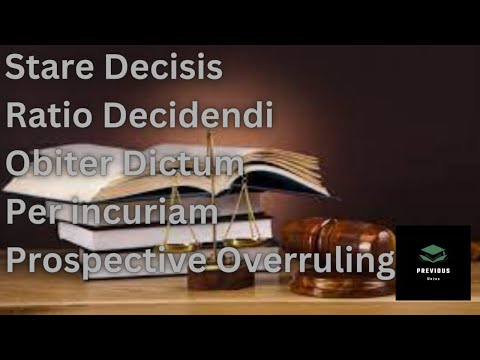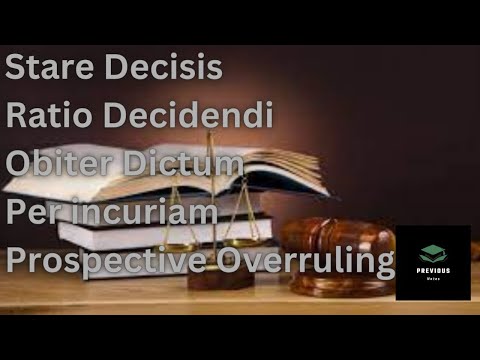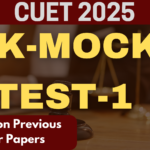
- Stare Decisis
- Ratio Decidendi
- Obiter Dictum
- Per incuriam
- Prospective Overruling
Stare Decisis
“Stare decisis” is a Latin term that means “to stand by things decided.” It is a legal doctrine that refers to the principle of following precedent, which involves courts making decisions based on previous rulings in similar cases. The idea is to maintain consistency and predictability in the legal system. Here’s an elaboration on the key aspects:
-
Definition:
- Stare Decisis: Translates to “to stand by things decided.” It’s a principle in legal systems that decisions made in prior cases should be followed as precedent in similar cases.
-
Application of Stare Decisis:
- Similar Legal Issues or Facts: Stare decisis is applied when there are similar legal issues or facts in a current case as compared to previous cases that have already been decided.
-
Hierarchy in Courts:
- Binding Effect: Under the doctrine of stare decisis, a court is generally bound to follow the legal principles established by higher courts within its own hierarchy. For example, a lower court is obligated to follow the decisions of a higher appellate court.
-
Consistency and Predictability:
-
Promotes Consistency: Stare decisis promotes consistency in legal decision-making by ensuring that similar cases are decided similarly. This helps in treating like cases alike, providing a sense of fairness and justice.
-
Predictability: Parties involved in legal disputes and the legal community, in general, benefit from the predictability that stare decisis provides. By relying on precedent, individuals can anticipate how a court might decide a case based on past decisions.
-
-
Legal Stability:
- Stability in the Law: Stare decisis contributes to legal stability by creating a system where the law evolves incrementally over time. Changes in legal principles are gradual, and decisions are built upon existing case law.
-
Exceptions and Overruling:
-
Adaptability: While stare decisis is a strong principle, it is not absolute. Courts can depart from precedent under certain circumstances, such as when a previous decision is considered incorrect or outdated. This is known as overruling.
-
Changing Legal Landscape: The legal system recognizes that societal values and understandings can evolve, requiring a degree of flexibility. In such cases, courts may decide to depart from precedent to adapt to changing circumstances.
-
Ratio Decidendi
-
The term “ratio decidendi” is a Latin phrase that translates to “reason for the decision.” It is a crucial concept in legal reasoning and refers to the legal principle or rule of law that forms the basis for a court’s decision in a specific case. The ratio decidendi serves as the precedent that must be followed in similar cases in the future. Here’s an elaboration on the key aspects:
-
Definition of Ratio Decidendi:
-
Legal Principle or Rule: Ratio decidendi represents the specific legal principle or rule of law upon which a court’s decision in a particular case is grounded.
-
Reason for the Decision: It is the “reason for the decision” and constitutes the essential and necessary elements of the decision that have a broader application beyond the specific facts of the case.
-
-
Role of Ratio Decidendi in Precedent:
-
Creation of Precedent: The ratio decidendi of a case becomes the precedent that must be followed in similar cases in the future. This is a key aspect of the development of common law legal systems.
-
Binding Effect: The ratio decidendi is the aspect of a precedent that is binding on lower courts. Lower courts within the same jurisdiction are generally obligated to follow the established ratio decidendi of higher courts.
-
-
Closely Related to Precedent:
-
Relationship with Precedent: Ratio decidendi and precedent are closely related because the former creates the latter. When a court decides a case, it not only resolves the specific dispute but also establishes a legal principle or reasoning that is to be followed in analogous situations.
-
Consistency and Predictability: This relationship between ratio decidendi and precedent contributes to the consistency and predictability of the legal system, as similar cases are expected to be decided in a consistent manner over time.
-
-
Essential Element of Precedent:
-
Binding Nature: While a judicial decision may contain various elements, the ratio decidendi is the essential element that carries the binding force. It represents the legal principle that future cases must adhere to.
-
Distinguishing Precedents: Courts often distinguish between the essential ratio decidendi of a case and its obiter dicta (non-binding remarks or comments). Only the ratio decidendi is binding on future cases.
-
-
Application and Importance:
-
Guidance for Future Cases: The ratio decidendi serves as guidance for judges and legal practitioners in future cases with similar legal issues. It helps in the application of consistent legal principles.
-
Development of Law: Over time, the accumulation of ratio decidendi contributes to the development of legal doctrines and the evolution of the law.
-
In summary, ratio decidendi is a foundational concept in legal reasoning, representing the reason for a court’s decision and forming the basis for the creation of precedent. Its binding nature on lower courts ensures consistency and predictability within the legal system.
-
Obiter Dictum
“Obiter dictum” is another Latin legal term that translates to “said by the way” or “remark in passing.” It refers to statements made by a judge in a legal opinion that are not essential to the decision in the case. Unlike the “ratio decidendi,” which is the core legal principle or rule forming the basis of the decision and setting precedent, obiter dicta are non-binding comments or observations.
Key characteristics of obiter dictum include:
-
Non-Binding Nature:
-
Not Essential to the Decision: Obiter dicta are statements or observations made by a judge that are not crucial to the resolution of the legal issues in the case. They are incidental and unnecessary for the decision.
-
Non-Binding: Unlike the ratio decidendi, obiter dicta are not binding on future cases. They do not create legal precedent and are considered as non-authoritative remarks.
-
-
Examples of Obiter Dicta:
-
Hypothetical Scenarios: Judges might discuss hypothetical scenarios or offer opinions on legal questions that are not directly relevant to the case at hand. These statements fall into the category of obiter dicta.
-
Comments on Future Law: If a judge comments on how the law should develop in the future or expresses a personal opinion on a legal issue that is not directly relevant to the case, those remarks are considered obiter dicta.
-
-
Distinguishing from Ratio Decidendi:
-
Identifying Essential Elements: To distinguish between obiter dicta and ratio decidendi, it is important to identify the essential elements of the decision—the ratio decidendi is the core legal principle upon which the decision rests.
-
Binding Effect: While the ratio decidendi is binding on future cases, obiter dicta have no binding effect. They are considered persuasive at most.
-
-
Use in Subsequent Cases:
-
Persuasive Value: While obiter dicta are not binding, they may have persuasive value in subsequent cases. Legal practitioners and scholars might consider these remarks as insightful commentary, but they are not legally obligatory.
-
Context Matters: The context in which obiter dicta are made can influence their perceived importance. If a judge is offering commentary on a legal principle central to the case, even if not strictly necessary, it might be given more weight.
-
-
Caution in Citation:
- Selective Citation: When citing legal opinions, it is crucial to distinguish between ratio decidendi and obiter dicta. Legal professionals should exercise caution and not rely on non-binding statements as if they were authoritative law.
In summary, obiter dictum refers to non-essential remarks or comments made by a judge in a legal opinion that do not form the basis of the decision and are not binding on future cases. Understanding the distinction between obiter dicta and ratio decidendi is important for accurate legal analysis and citation.
Per incuriam
“Per incuriam” is a Latin term in legal language that translates to “through lack of care” or “through inadvertence.” It refers to a judicial decision or judgment that has been made without the court considering a relevant statutory provision or a binding precedent that should have been applied in the case. When a decision is rendered per incuriam, it is considered to be made in error, and it is not treated as binding precedent.
Key characteristics of the doctrine of per incuriam include:
-
Failure to Consider Relevant Law:
- Lack of Consideration: Per incuriam situations arise when the court fails to consider or overlooks a relevant statutory provision, legal principle, or binding precedent that should have been taken into account in making its decision.
-
Non-Binding Nature:
-
Error and Lack of Precedential Value: A decision made per incuriam is not considered binding as a precedent. It is viewed as an erroneous decision due to the court’s failure to properly consider applicable laws or precedents.
-
No Stare Decisis Effect: The principle of stare decisis, which requires courts to follow precedent, does not apply to decisions made per incuriam. Such decisions are not recognized as authoritative legal principles.
-
-
Intention to Promote Accuracy and Consistency:
-
Promoting Judicial Accuracy: The doctrine of per incuriam is intended to promote the accuracy and consistency of judicial decisions. By acknowledging and correcting errors, the legal system aims to ensure that legal principles and precedents are appropriately considered and applied in every case.
-
Preserving Legal Integrity: Recognizing and rectifying decisions made in error through the per incuriam doctrine helps maintain the integrity of the legal system and enhances the reliability of judicial decisions.
-
-
Rectification of Errors:
- Correction of Mistakes: When a court identifies that its previous decision was made per incuriam, it may take steps to correct the mistake. This correction can occur through subsequent decisions or through specific legal procedures designed to address errors.
-
Application in Legal Practice:
-
Challenging Precedents: Legal practitioners may invoke the doctrine of per incuriam to challenge the authority of a precedent if they can demonstrate that the decision was made without proper consideration of relevant legal principles.
-
Clarification of Legal Issues: Courts may use the doctrine to clarify and correct errors in their own decisions or the decisions of other courts, aiming to ensure that the law is applied correctly and consistently.
-
In summary, per incuriam is a legal concept that signifies a decision made in error due to the court’s failure to consider relevant statutory provisions or binding precedents. Recognizing decisions made per incuriam helps maintain the accuracy and consistency of judicial decisions by ensuring that legal principles are appropriately applied in all cases.
Prospective Overruling
“Prospective overruling” is a legal doctrine or principle that allows a court to change or overturn its own precedent, but the change applies only to future cases and not retroactively to cases that have already been decided. In other words, the new rule or interpretation established by the court will only affect cases that arise after the decision is made, leaving past decisions undisturbed.
Key features of prospective overruling include:
-
Change in Precedent:
- Overturning Previous Decision: Prospective overruling involves a court deciding to overturn or modify a previous decision, often because the court believes the prior decision was incorrect or needs updating.
-
Application to Future Cases:
-
Forward-Looking Impact: The change in precedent is applicable only to cases that arise after the date of the new decision. Past cases that were decided based on the old precedent are not affected or reopened.
-
Avoiding Disruption: Prospective overruling is designed to prevent disruption and uncertainty caused by changing the legal rules for cases that have already been resolved.
-
-
Reasons for Prospective Overruling:
-
Legal Evolution: Courts may adopt prospective overruling to adapt the law to changing circumstances, evolving societal values, or a better understanding of legal principles.
-
Balancing Interests: The court may consider the interests of finality and stability in legal decisions, weighing them against the need for legal evolution and correction of past errors.
-
-
Balance between Stability and Flexibility:
-
Stability in the Law: Prospective overruling contributes to the stability of legal decisions, providing a sense of finality and predictability for cases that have already been litigated.
-
Flexibility for Change: At the same time, it allows the legal system to adapt and correct errors, ensuring that the law remains dynamic and responsive to evolving needs.
-
-
Clarification and Guidance:
-
Guidance for Future Cases: The court may use prospective overruling to provide guidance on the direction of the law, signaling to lower courts and practitioners how the law will be interpreted in future cases.
-
Avoiding Unjust Outcomes: This approach helps avoid unjust outcomes by ensuring that individuals can rely on the legal rules as they existed at the time of their actions or legal disputes.
-
-
Not Universal:
- Jurisdictional Differences: The availability and application of prospective overruling may vary among jurisdictions. Some legal systems may expressly recognize and allow it, while others may have different approaches to changing precedent.
Prospective overruling strikes a balance between legal stability and adaptability. It allows courts to correct errors and update legal rules while providing a degree of finality and predictability for cases that have already been decided. This approach acknowledges the need for a dynamic legal system that can respond to changing circumstances without causing undue disruption to settled matters.
In Short:
Stare Decisis
- “to stand by things decided.”
- similar legal issues or facts.
- Under the doctrine of stare decisis, a court is generally bound to follow the legal principles established by higher courts within its own hierarchy.
- promotes consistency and predictability in the legal system.
Ratio Decidendi
- Ratio decidendi refers to the legal principle or rule of law that is the basis for a court’s decision in a particular case. It is the “reason for the decision” and sets the precedent that must be followed in similar cases in the future.
- Ratio decidendi and precedent are closely related because the ratio decidendi of a case becomes the precedent that must be followed in similar cases in the future.
- The ratio decidendi is the essential element of a precedent that is binding on lower courts
Obiter Dictum
- It is a remark made in passing or by way of opinion, rather than a necessary part of the reasoning that leads to the court’s judgment.
- Unlike the ratio decidendi, which creates a binding precedent, an obiter dictum has no binding legal effect and does not establish a precedent that must be followed in future cases.
Per incuriam
- a decision or judgment that has been made without considering a relevant statutory provision or a binding precedent that should have been applied in the case.
- When a decision is made per incuriam, it is considered to be made in error and is not binding as a precedent.
- The doctrine of per incuriam is intended to promote the accuracy and consistency of judicial decisions by ensuring that legal principles and precedents are properly considered and applied in all cases.
Prospective Overruling
- that allows a court to modify or overturn a previous decision but to limit the effect of that decision to future cases.
- It can also be used to avoid unjust outcomes in cases where a previous decision has been rendered obsolete by changing social or economic circumstances.


















Leave a Reply